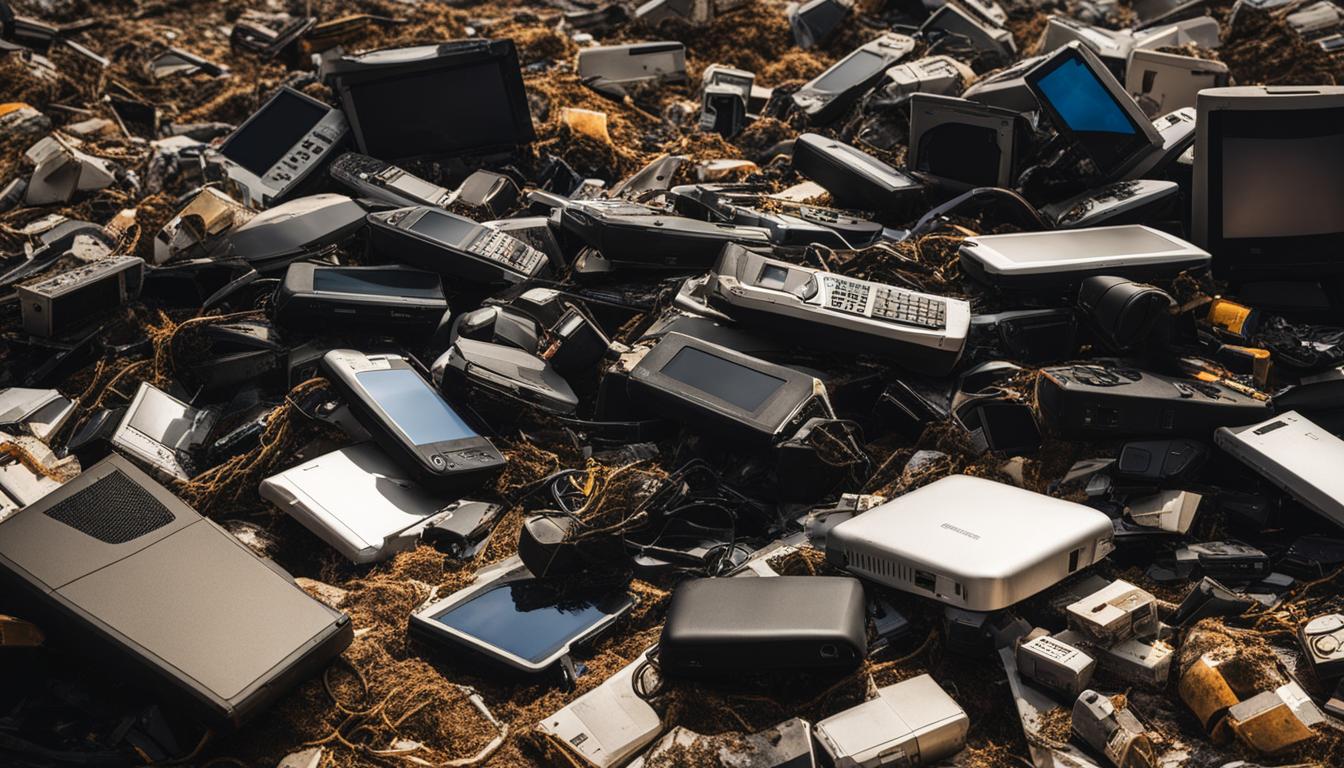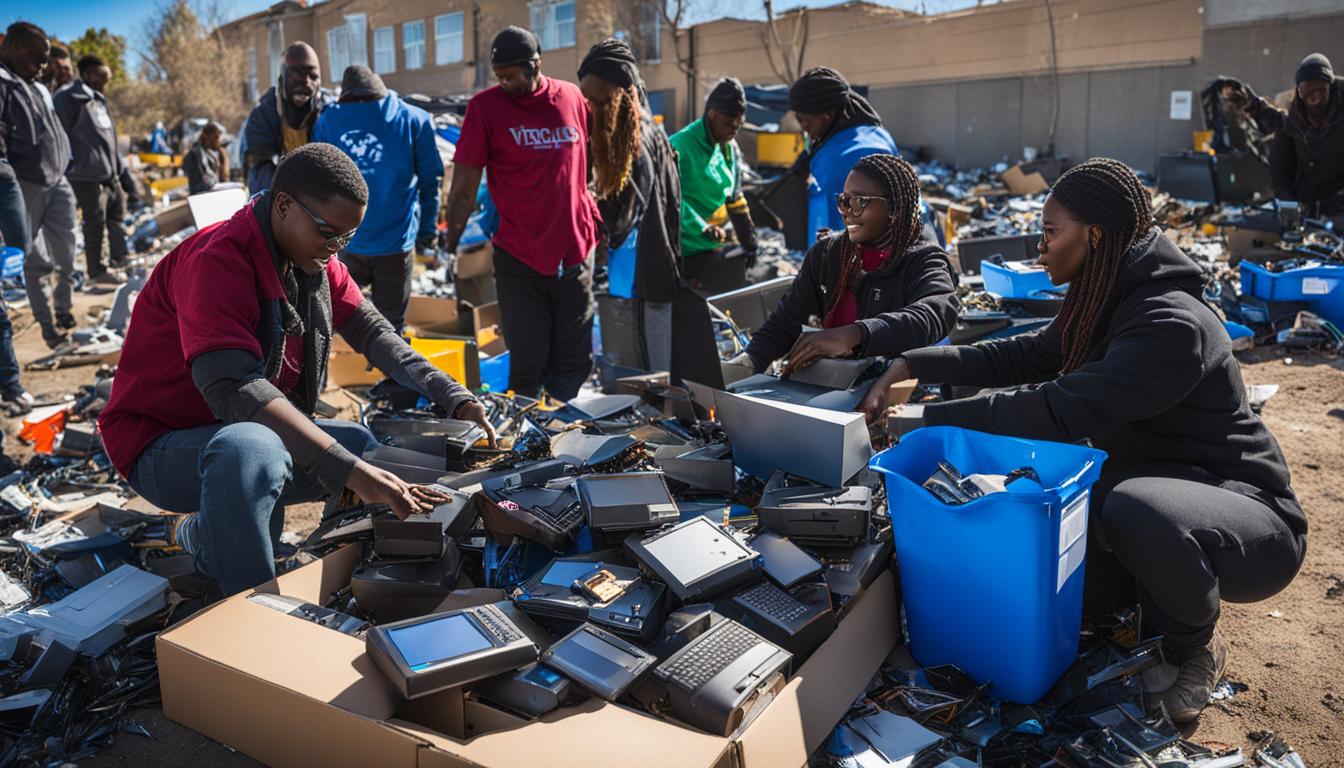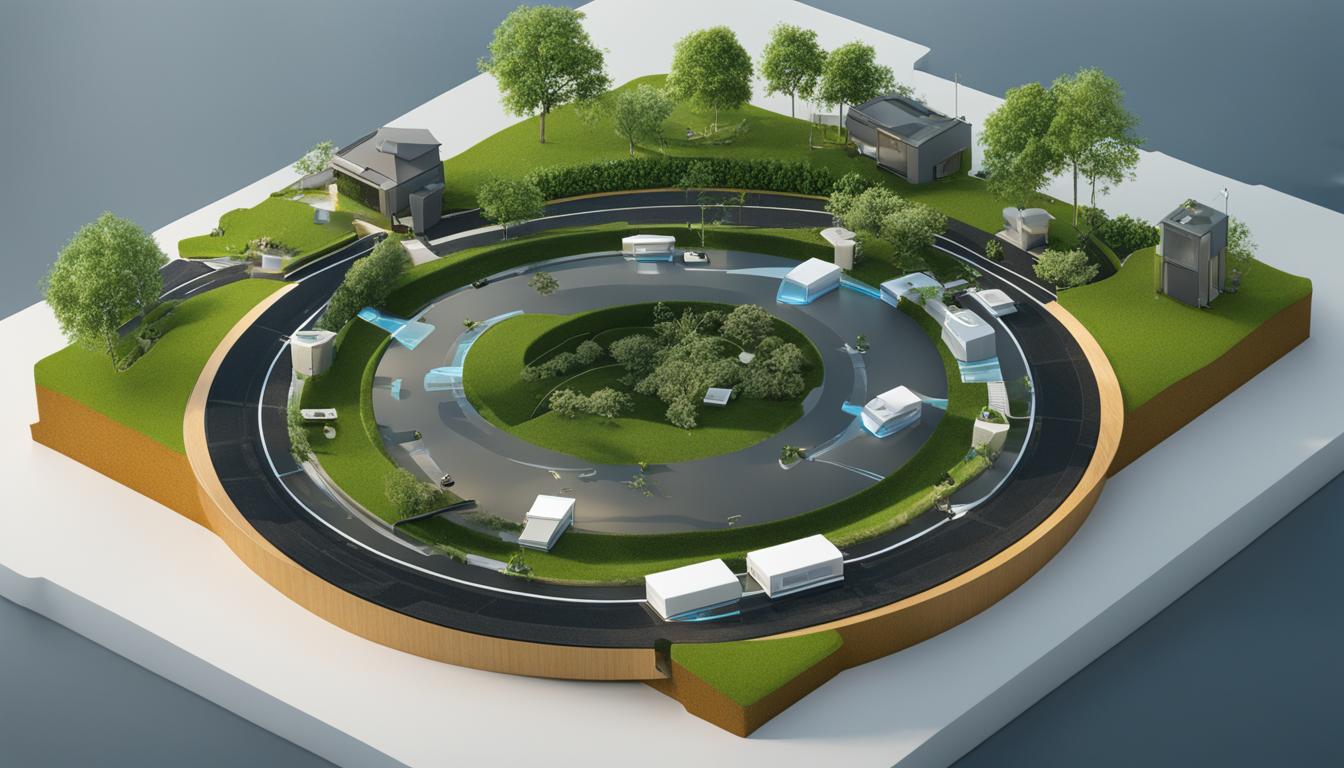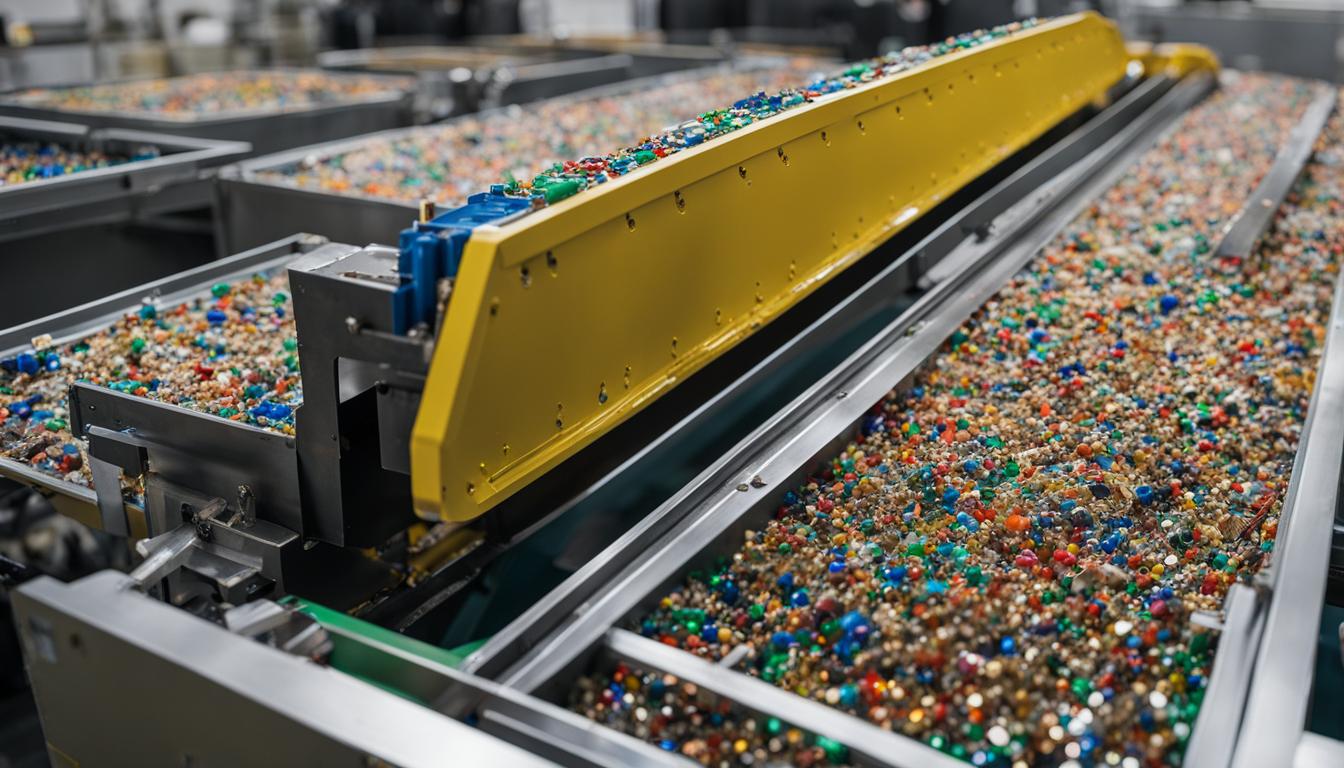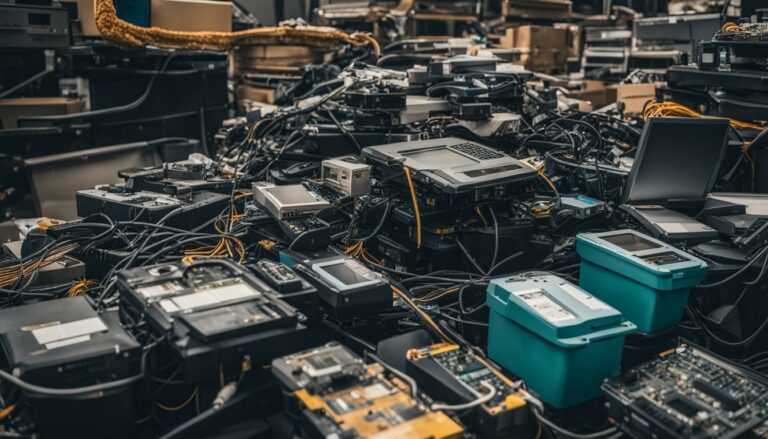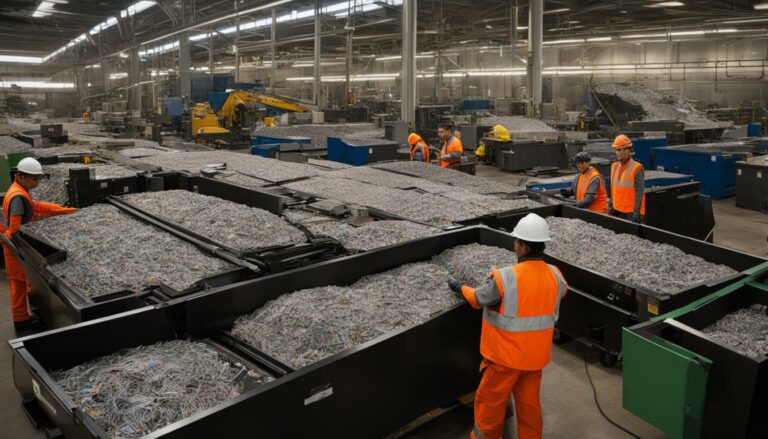Understanding the IT Recycling Process
When it comes to electronic waste disposal, responsible recycling is crucial for the environment and sustainable resource management. The IT recycling process offers a step-by-step approach to responsibly dispose of electronic waste and promote IT asset management. By understanding the intricacies of e-waste recycling, we can contribute to a circular economy and ensure the efficient use of valuable resources.
Key Takeaways
- The IT recycling process is essential for responsible electronic waste disposal.
- Proper IT asset management ensures the efficient use of resources.
- Responsible recycling practices contribute to a circular economy.
- Understanding the IT recycling process helps increase the recyclability of products.
- E-waste recycling plays a vital role in sustainable resource management.
Recycling Plastics in the IT Recycling Process
Plastics play a significant role in the IT recycling process. Different types of plastics require specific recycling processes due to their chemical components. The collection of plastic waste can be done through government-led recycling programs or private waste disposal companies. Plastic sorting is essential to separate different varieties of plastic, and it can be done manually or with the help of sorting machines. Washing the sorted plastics removes any debris or contamination that may hinder the recycling process. Shredding the plastics into smaller pieces makes them easier to handle and identify any remaining impurities. The final step in plastic recycling is pelleting, where the crushed pieces are melted down and compressed into plastic pellets. These pellets can then be sent to manufacturers for further use in the recycling process.
Recycling plastics in the IT recycling process offers environmentally friendly disposal solutions for IT equipment. By properly recycling plastics, we can reduce the amount of plastic waste that ends up in landfills or incinerators, thus minimizing the negative impact on the environment. This process also helps conserve resources and reduce the need for new plastic production, which requires significant amounts of energy and contributes to greenhouse gas emissions. Implementing efficient plastic recycling methods within the IT recycling process is crucial in promoting sustainability and responsible waste management.
Table: Plastic Recycling Process in the IT Recycling Process
| Step | Description |
|---|---|
| Collection | Gather plastic waste through recycling programs or waste disposal companies |
| Sorting | Separate different types of plastic through manual or machine-assisted sorting |
| Washing | Clean the sorted plastics to remove debris and contamination |
| Shredding | Crush the plastics into smaller pieces for easier handling and impurity identification |
| Pelleting | Melt down and compress the crushed plastics into plastic pellets for further use in manufacturing |
By incorporating plastic recycling into the IT recycling process, we can contribute to a more sustainable future by minimizing waste and maximizing resource utilization. It is essential for individuals and organizations to support and participate in IT equipment recycling programs to ensure responsible disposal of plastics and other electronic waste.
The Importance of the IT Recycling Process for Sustainability
The IT recycling process plays a crucial role in promoting sustainable practices and protecting the environment. By responsibly disposing of electronic waste, we can conserve resources, minimize the amount of waste that ends up in landfills, and recover valuable materials that are in limited supply.
One important aspect of the IT recycling process is secure data destruction. As organizations upgrade their IT equipment, it is vital to ensure that sensitive information is properly destroyed to prevent unauthorized access. By securely managing data throughout the recycling process, we can protect personal and confidential information, mitigating the risk of data breaches.
Proper IT asset management is also essential for sustainability. By efficiently and effectively utilizing valuable resources, we can reduce waste and promote a circular economy. Through comprehensive asset tracking, organizations can identify opportunities for reusing or refurbishing IT equipment, prolonging its lifespan and reducing the need for new production.
| Benefits of the IT Recycling Process for Sustainability |
|---|
| Conserves resources |
| Reduces landfill waste |
| Recovers valuable materials |
| Protects sensitive data |
| Promotes a circular economy |
The IT recycling process is a vital component of responsible waste management and sustainable practices. By embracing this process, we can contribute to a healthier planet and ensure the longevity of valuable resources for future generations.
Global Challenges and Legislation for E-Waste Recycling
The global generation of e-waste is increasing rapidly, with estimates indicating that around 50 million metric tons of e-waste are produced annually. E-waste contains hazardous materials and substances, making its proper management crucial to prevent pollution and negative impacts on human health. Various policies and legislations have been developed globally to address the e-waste problem, including extended producer responsibility (EPR) principles. EPR places the responsibility on manufacturers to design products in a way that minimizes waste management costs. However, there are challenges in managing e-waste, such as the lack of infrastructure for collection and separation, illicit e-waste trade, and the fragility of the formal recycling sector.
The lack of proper infrastructure for e-waste collection and separation poses a significant challenge in many parts of the world. Inadequate recycling facilities and limited accessibility hinder the efficient disposal of electronic waste. Governments, organizations, and stakeholders need to invest in developing comprehensive infrastructure to facilitate the collection, sorting, and recycling of e-waste.
The illicit trade of e-waste is another pressing issue that undermines sustainable e-waste recycling efforts. Illegal dumping and export of electronic waste to developing countries with lax regulations not only contribute to environmental degradation but also pose health risks to local communities. Strengthening international cooperation and implementing stricter regulations are crucial to combat this illicit trade and promote responsible e-waste recycling.
The formal recycling sector also faces challenges due to the complexity and diversity of electronic waste. E-waste consists of various components and materials, requiring specialized knowledge and technologies for safe and efficient recycling. Additionally, the rapid advancement of technology leads to new types of electronic waste that may not have established recycling processes. Continuous research and development in e-waste management are essential to keep up with the evolving nature of electronic devices and ensure sustainable use of resources.
Table: Comparison of E-Waste Recycling Legislation
| Country | Legislation | Key Features |
|---|---|---|
| United States | Resource Conservation and Recovery Act (RCRA) | – Requires proper disposal and tracking of hazardous electronic waste – Enforces recycling targets for electronic manufacturers |
| European Union | Waste Electrical and Electronic Equipment (WEEE) Directive | – Mandates the collection, recycling, and recovery of electronic waste – Imposes responsibility on producers for end-of-life product management |
| Japan | Act on Promotion of Recycling of Small Waste Electrical and Electronic Equipment | – Establishes a framework for collecting and recycling small electronic waste – Requires retailers to facilitate the return of small electronic devices |
| China | Law on the Prevention and Control of Environmental Pollution by Solid Wastes | – Prohibits the import of hazardous electronic waste – Encourages the development of domestic recycling facilities |
These legislations and regulations aim to promote responsible e-waste recycling, reduce the environmental impact of electronic waste, and ensure the sustainable use of resources. However, their effectiveness depends on proper enforcement, public awareness, and collaboration between governments, manufacturers, and consumers.
Conclusion
The IT recycling process is vital for promoting sustainable practices and protecting the environment. By understanding the step-by-step process of recycling, we can increase the recyclability of products through ecodesign and support responsible recycling efforts. It is important to manage e-waste effectively, considering the challenges and implementing proper legislation.
The global generation of e-waste is increasing rapidly, with approximately 50 million metric tons produced annually. The proper management of e-waste is crucial to prevent pollution and negative impacts on human health. Various policies and legislations, including extended producer responsibility (EPR) principles, have been developed globally to address this issue. EPR places the responsibility on manufacturers to design products with waste management in mind, reducing the environmental impact.
By embracing the IT recycling process, we can contribute to a circular economy and conserve resources for future generations. Sustainable recycling practices not only reduce the amount of waste that ends up in landfills but also help recover valuable materials that are in limited supply. Additionally, secure data destruction and proper IT asset management ensure the protection of sensitive information and the utilization of resources efficiently and effectively.
Together, through responsible e-waste recycling and sustainable practices, we can make a significant impact on the well-being of our environment and create a more sustainable future.
FAQ
What is the IT recycling process?
The IT recycling process involves responsibly disposing of electronic waste through steps such as recycling large appliances, fluorescent tubes and lamps, small electrical and electronic appliances, CRT screens, and plastics.
How are plastics recycled in the IT recycling process?
Different types of plastics require specific recycling processes. Plastic waste can be collected through government-led programs or private waste disposal companies. It is sorted, washed, shredded, and then pelleted to create plastic pellets for further use in the recycling process.
Why is the IT recycling process important for sustainability?
The IT recycling process helps conserve resources, protect the environment, and promote responsible recycling practices. It reduces waste in landfills and recovers valuable materials. Secure data destruction and proper IT asset management ensure efficient utilization of resources.
What are the global challenges and legislation for e-waste recycling?
E-waste management faces challenges such as infrastructure, illicit trade, and a fragile formal recycling sector. Various policies and legislations, including extended producer responsibility (EPR) principles, have been developed globally to address the e-waste problem.
How can embracing the IT recycling process contribute to a circular economy?
By understanding and implementing the IT recycling process, we can increase the recyclability of products through ecodesign and support responsible recycling efforts. This contributes to a circular economy that conserves resources for future generations.

